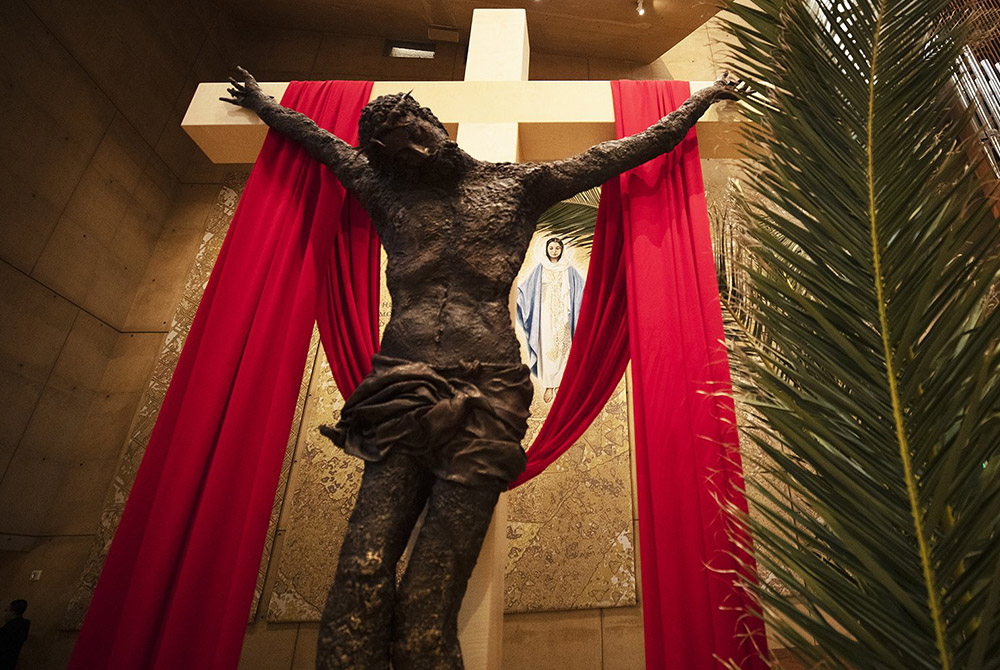
A crucifix is seen at the Cathedral of Our Lady of the Angels in Los Angeles on Palm Sunday, March 28. (CNS/Victor Aleman, courtesy of the Archdiocese of Los Angeles)
Every Good Friday, at St. Matthew's Cathedral in Washington, one of the hymns we would sing during the veneration of the cross was the Taize chant: "All you who pass this way."
Like all Taize chants, it is haunting both in its plaintive simplicity and its beauty, always the most profound artistic combination. These are the words of the hymn:
All you who pass this way, look and see,
Is any sorrow like the sorrow that afflicts me,
All you who pass this way, look and see,
Women of Jerusalem, do not weep for me,
But for yourselves and for your children.
All you who pass this way, look and see,
Father, forgive them, for they know not what they do.
All you who pass this way, look and see,
My God, my God, why have you abandoned me?
All you who pass this way, look and see.
Do we look? Do we see?
Of all the Christian holidays, this is the day from which there is no uplifting message to be drawn. There are no ethical lessons to be drawn: Today is about something deeper, something more primordial in Christian spirituality than mere ethics. It is the artists, not the essayists or theoreticians, who come closest to expressing the abysmal horror of this day, reaching into the depths of our souls. Can anyone listen to the hymn above and not get choked up? Can we gaze upon a sculpted or painted Pietà and be unmoved?
All Christian worship points us beyond the horizon of human cognition, but it is Good Friday that most distinguishes the Christian faith from all others. Moses died an old man as did Muhammad and the Buddha and Confucius. The idea of a crucified God is, as St. Paul wrote to the Corinthians, "a stumbling block to the Jews and folly to the gentiles" (1 Corinthians 1:23). It turns everything upside down. The Mystery, the Absolute, are always beyond the horizon, but Good Friday brings the Mystery into that most granular and tactile of human events, death.
Before the crucified Christ, we fall silent. It is fitting that the celebrant enters the sanctuary today in silence. It is fitting that today there is no organ music, no manmade instruments, in our liturgy, only the human voice. It is fitting that today the red vestments evoke both martyrdom and the presence of the Holy Spirit who alone permits us to see through the eyes of faith that this horrific, painful, dreadful image of a man being executed in such a cruel manner has become, for us, the very form of the beautiful.
No theologian in our time did more to retrieve the theological significance of beauty than the great Swiss theologian Hans Urs von Balthasar. In reflecting on the mystery revealed by the crucified Christ, he observed that the Catholic Church's "most essential forces — prayer, suffering, faithful obedience, readiness (perhaps unexploited), humility — elude all statistical analysis." Our Catholic faith is not hostile to reason, but it is out of sync with the Cartesian "cogito" and all of its varied, modern children. There is nothing utilitarian, nor commonsensical, nor pragmatic, about the crucified Christ. The need for self-assertion in our own time, the dyspeptic clamor for affirmation, these sit ill with the self-emptying model the crucified paints for us today.
Advertisement
We Christians are not wrong to fight injustices where we find them, but we are wrong when we fail to realize that our efforts will always fall short, that hatred will never be entirely stamped out and our hopes will never be entirely fulfilled, that the eschaton is always beyond our reach. Why is it we must fight for justice, for dignity, for our dreams, generation after generation? The Gloria at Mass, which returned after so long an absence at last night's liturgy, tells us that the Savior's birth was greeted by the angels with the promise of peace on earth to men of goodwill, but we are still waiting all these years later. We find a foretaste of that peace not in our own efforts, but here, in the body and blood of Christ offered for us at Calvary and offered again and again at the altar.
The corpus on the crucifix is one of the distinctive aspects of our Catholic faith. I remember being 13 and starting to visit churches of other denominations. I was learning to play the organ and never tired of trying new instruments. I noticed that the Episcopal churches and the Lutheran churches and the Congregational churches, their crosses never had a corpus. They were bare. Tasteful. Less gruesome.
All you who pass this way, look and see. The grim and gruesome corpus demands our attention. Look and see. Say nothing. "This is the wood of the Cross, on which hung the Savior of the world. Come, let us worship."
All you who pass this way, look and see.








